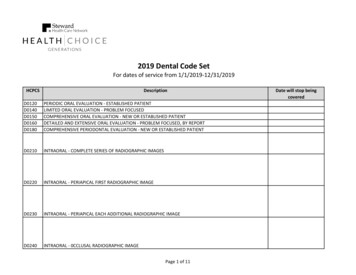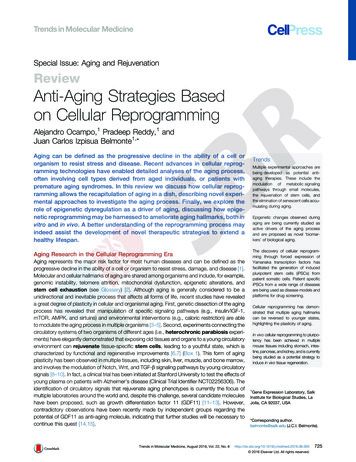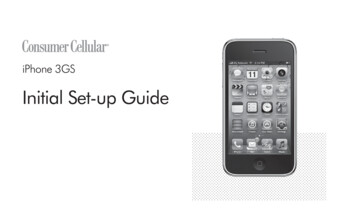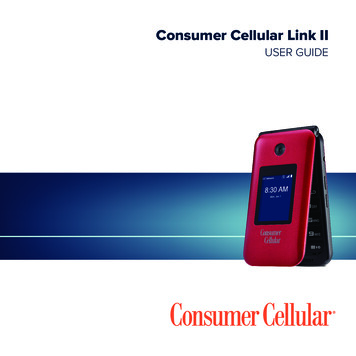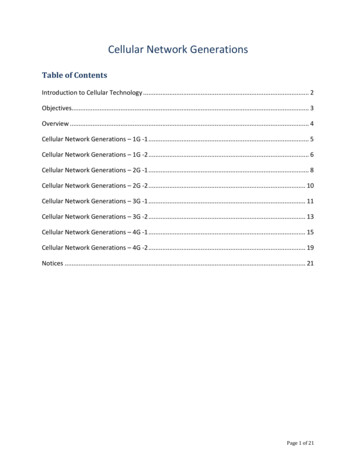
Transcription
Cellular Network GenerationsTable of ContentsIntroduction to Cellular Technology . 2Objectives. 3Overview . 4Cellular Network Generations – 1G -1 . 5Cellular Network Generations – 1G -2 . 6Cellular Network Generations – 2G -1 . 8Cellular Network Generations – 2G -2 . 10Cellular Network Generations – 3G -1 . 11Cellular Network Generations – 3G -2 . 13Cellular Network Generations – 4G -1 . 15Cellular Network Generations – 4G -2 . 19Notices . 21Page 1 of 21
Introduction to Cellular TechnologyIntroduction to CellularTechnology 2012 Carnegie Mellon University**001 So Introduction to CellularTechnology. Again, the fun notice.I'm going to skip it. It's in your slidehandouts if you want to actually readit.Page 2 of 21
ObjectivesObjectivesAt the completion of this module, students should be familiarwith: Generations of cellular technologiesTypes and capabilities of cellular networksGovernment standards related to cellular devicesCellular device components3**003 So at the completion of this, youshould be familiar with these items.What are the different generations ofcellular technology? This mostlyapplies to the network side. What is11G, what is 2G? What exactly- whatcapabilities does 4G have that theother generations do not have?The types and capabilities of cellularnetworks. How does GSM differ fromCDMA? How are they actuallytransmitting data? How do the celltowers actually work?Government standards related tocellular devices. Most of thestandards are going to be based onPage 3 of 21
FCC regulations because they controlthe airwaves in the United States.There's other governing bodies thatcontrol the airspace in othercountries. Some countries there isno control over the airspace. We'regoing to focus on the U.S. regulations.And then the components that makeup a cellular device.OverviewOverviewGenerations of Cellular Technologies Evolution from 1st – 4th Generation Mobile DevicesTypes and Capabilities of Wireless Networks CMDA vs. TDMABluetoothIEEE 802.11US Government Security Standards4**004 The generations of cellulartechnologies. Evolution from 1stGeneration to 4th Generation. Whathas happened with the devices?What features have been addedalong the way that weren't availablein older generations?Page 4 of 21
CDMA versus TDMA. These are theunderlying technologies of the CDMAand GSM networks. Bluetooth, IEEE802.11 or Wi-Fi, and the USGovernment Security Standards.Cellular Network Generations – 1G -1Cellular Network Generations – 1G -11st Generation (1G) Introduced for public use 1981 100% Analog— No Data!! AMPS – Advanced Mobile Phone System5**005 So 1st Generation. First introducedfor public use in 1981. A hundredpercent analog; no data wasavailable. The problem with it beinganalog was anyone with a frequencyscanner could listen in on yourconversations.The problem with no data is you havenothing like SMS. You have MMSmessages. You could only sendphone calls. It actually usedPage 5 of 21
frequency modulation to send thesignal. So since it's analog, it took upthe entire signal, the entire frequencyit was transmitting on. So there wasvery few users per cellular tower.AMPS is the Advanced Mobile PhoneSystem. That was introduced in 1978in the United States. That is theUnited States version for allowing 1stgeneration communication. Veryexpensive; not secure; not widelyused. Very expensive for somebodyto use it.Cellular Network Generations – 1G -2Cellular Network Generations – 1G -2Very Expensive – Not Secure Not widely used Mobile units available in cars6**006 Most often these were businesspeople that were using 1st generationtechnology. Most people youPage 6 of 21
wouldn't see having their own personphone. They're very big, they're verybulky; battery did not last a longtime.It shows mobile units available incars. There was actually car unitsavailable in other countries muchearlier than 1978 when AMPS wasintroduced. So the car technology isreally what spawned the rest of thecellular technology: very bigbatteries; wasn't something youcould carry around. But Sweden,Norway had a system with carphones I think as early as the '50s or'60s.And so the cellular revolution thenwas just a shoot-off. As batteriesbecame better, as these devices gotbecame smaller and didn't require asmuch power, that's when we startedbeing able to see actual cellulardevices not hooked up in a car.Page 7 of 21
Cellular Network Generations – 2G -1Cellular Network Generations – 2G -12nd Generation (2G and 2.5G) Introduced 1991 100% Digital Availability of data— 10 144 Kbps transfer Emergence of SMS (Simple Message Service), MMS (MultimediaMessage Service), and mobile Internet CDMA (Code Division Multiple Access) vs. GSM (Global System forMobile Communications)7**007 So 2nd Generation. The 2ndgeneration of networks wasintroduced in '91. A hundred percentdigital. So now instead of being ableto use a frequency scanner andlistening in on all the calls locatednear me, there's- it's all digital.With digital, we started gettingencryption.We get very low data rates. We'retalking about 10 Kbits/sec, up to 144Kbits/sec. This is when we startseeing SMS and MMS messagesavailable on cellular devices. That'sabout all you could do over-- youcould do other stuff over 2G. But thePage 8 of 21
data rate is so slow. I wouldn't wantto do like a video call over 2G. It'sjust too slow.We see the emergence of SMS, MMSand mobile Internet. You can finallykeep up with your favorite fantasyfootball teams on your phone, if youreally want to. It's just going to take110 minutes to load Yahoo in order tosee what your match ups for theweek are.This is also where we start seeingCDMA-- which is Code DivisionMultiple Access-- versus GSMnetworks; Global System for MobileCommunications.We'll get into later in the block forthe U.S. pretty equivalent number ofusers on the two systems.Worldwide that's not necessarily thecase. GSM has many more usersthan CDMA because GSM wasactually introduced in Europe.So they created it. They startedrolling it out to their countries andcountries that they had relationshipswith; and the U.S. decided wellQualcomm's part of the U.S.; let's goahead and introduce CDMA networksalso.Page 9 of 21
Cellular Network Generations – 2G -2Cellular Network Generations – 2G -2Competition Market for cell phones grows exponentially Network providers face off8**008 Market for cell phones growexponentially. This is when you startseeing people walking around withpersonal cell phones; not justbusiness use anymore. I can nowuse-- I want to keep in touch. I feelnaked now if I don't have a cellphone on me. I want to be able toget my wife's email message or textmessage or voice call wherever I'mlocated.Cell phones allow you to beconnected. I travel a lot. The lasttwo months I've been out of thecountry for basically a month of thetime. So having the cellular device isone of the ways that I can keep inPage 10 of 21
touch with the people back in SanAntonio where I'm from. Without thecell phone, I would be gone for 18days and might not have any type ofcommunication if the place I was atdidn't have wireless.The network providers face off.Network providers at this pointdecided are we going to be a GSMnetwork; are we going to be a CDMAnetwork?Cellular Network Generations – 3G -1Cellular Network Generations – 3G -13rd Generation (3G) Introduced 2001 Improved network speeds— 384 Kbps 3 Mbps GSM vs. CDMA20009**009 3rd Generation. Introduced in 2001.The data rates increaseexponentially. So instead of having110 to 144 kilobits, we have 384kilobits to up to 3 Mbits/sec. So thePage 11 of 21
speeds are much, much faster. Wecan actually start doing stuff likeusing it as a replacement for yourhome internet service.Three Mbits/sec is probably a speedyou'll never see in the real world.That's like best-case scenario is 3Mbits/sec on the network. Mostusers probably see no more than 11/2Mbits/sec to 2 Mbits/sec. But it's stillfast enough that when I'm out of thehouse-- or even if I'm in the housesitting on my couch-- instead ofhaving to go to the computer to dosomething, I just do it on the cellphone instead; because it's goodenough.GSM versus CDMA2000. At this pointwe see a- we see the type ofnetworks being used start to merge alittle bit. So we'll get into what TDMAis, and how it works, and how CDMAworks. But with GSM andCDMA2000, the CDMA networks startusing some of the principles ofTDMA, and the GSM networks startusing some of the principles ofCDMA. Because they had startedrunning into issues with the waythings were in the 2G world. So westart seeing a little bit of co-minglingbetween the type of technologiesthese phones are actually using.Page 12 of 21
Cellular Network Generations – 3G -2Cellular Network Generations – 3G -2Smart Phones Emerge Increased functionally Smaller form factor10**010 Smart phones emerge. This doesn'tmean there wasn't smart phonesbefore 3G networks; because therewere. Palm has had smart phonetype devices out for a long time; '90s,PDAs. PDA is the precursor to the smart phone.But with 3G, the data rates are nowfast enough, the technology is nowsmall enough, and the OSmanufacturers are smart enough tobe able- to start focusing theirdevices on the consumer level ratherthan on the business level.So you start seeing people like mymother get smart phones. Beforebasically the 3rd generation, shePage 13 of 21
would've been like, "Why do I need asmart phone? I don't need to beconnected all the time. I don't needto do email when I'm not at thehouse." Now she probably couldn'tlive without her smart phone.So we-- the OS manufacturers,especially Apple, were very, verysmart. They were very direct in theirfocusing. They definitely focused onthe consumer level at this point. Andat this point cell phones have becomeubiquitous. Everybody has a cellphone; at least everybody I know hasa cell phone. I know 12-year-old kidsthat have a cell phone, because theirparents want to be able to keep intouch with them, regardless of wherethey are.Page 14 of 21
Cellular Network Generations – 4G -1Cellular Network Generations – 4G -14th Generation (4G) Still under development (as of January 2012) Higher network capacity— 100% packet switched— IPv6 Data transfer rates drastically increased— 100Mbps 1Gbps LTE (Long Term Evolution) Advanced WiMAX (Worldwide Interoperability for Microwave Access)11*011 And now we're seeing the 4thgeneration rolling out. 4G network,the first 4G network in the U.S. wasSprint in 2000-and-- two years ago-2008/2009-ish is when they starteddeveloping it. The first 4G phonewas released in 2010; the Evo 4G.Sprint used a different technologythan the other phone companies inthe U.S. to get the first 4G phones onthe market. We'll discuss thedifference between WiMAX and LTElater on.It says "still under development".There's still work ongoing with the 4Gstandard. There are 4G networks outPage 15 of 21
there-- LTE is an approved 4Gnetwork-- but they're still working onthe standard and they're still workingon what exactly is a 4G network andwhat's not going to be included as a4G network.Higher network capacity. Thephones are now 100- the data sent is1100% packet switched. IPv6 isavailable. So it's-- they're trying tofuture proof the technology. As westart moving to IPv6 instead of IPv4,the 4G standard has that capabilitybuilt into it. So we're not going tohave like a Y2K problem with cellphones because the technology isalready built into 4G.Data transfer rates greatly increase.This says 100 Mbits/sec to 1Gbits/sec. Are you ever going to see11 Gbits/sec? Probably not. Are youever going to see 100 Mbits/sec?Probably not.My understanding is the Verizons andAT&Ts, LTE, is somewhere between20 and 40 Mbits/sec; depending onyour contracts, depending on howclose you are to a tower, and therebeing no interference between youand the cell phone tower. But that isexponentially greater than what wasavailable in 3G; and even 20Mbits/sec is faster than most usershave at home.I think my connection at home capsout at 12 Mbits/sec. Now we'retalking about 20 Mbits/sec over thephone. If it wasn't for data caps, Iwould be very tempted to cut myPage 16 of 21
home internet usage and just funneleverything over my phone'sconnection when I'm home.Now Verizon's and AT&T's data capspreclude that from happeningbecause they haven't raised the datacaps in the 4G world. So we're stilllooking at 2 Gigabits caps, 5 Gigabitcaps. With 4G, you can go throughthat very, very quickly.LTE, Long Term Evolution, Advanced.That's the next step in the LTE rollout. That's when we're going to startseeing potentially 100 Mbits/sec. Istill don't know if we're ever going toactually see those data rates on anetwork.I'm going to make a statement-- it'sgoing to
CDMA (Code Division Multiple Access) vs. GSM (Global System for Mobile Communications) **007 So 2nd Generation. The 2nd . generation of networks was . introduced in '91. A hundred percent . digital. So now instead of being able . to use a frequency scanner and . listening in on all the calls located . near me, there's- it's all digital.




